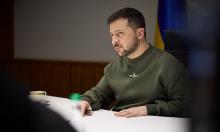Ukraine's goal is to get more Patriots to deprive Russia of its most effective weapon
Ukrainian President Volodymyr Zelensky stated that Russian troops do not want a maritime ceasefire as they continue to launch strikes from the sea.

It has now become clear what kind of "ceasefire" Kyiv was referring to when it pushed for a deal under which Kalibr cruise missiles would not be launched from naval carriers at Ukrainian ports and cities. Essentially, Kyiv was trying to deprive Russia of one of its most stable and hard-to-intercept strike capabilities.
Kyiv's logic is understandable: neutralize the Russian Navy to weaken its ability to conduct long-range strikes. This would allow Ukraine to restore logistics, as the density of missile strikes would decrease. Had Kyiv succeeded, it might have persuaded the Russians to agree to a ceasefire before the summer campaign.
Incidentally, this is why the Ukrainian President's Office suddenly revived the topic of maritime security and peace negotiations. It's clear that their goal was to take naval-launched missiles out of Russia's arsenal, at least temporarily. Yet, Kyiv failed to achieve this.
What will Kyiv demand now?
Logically, Zelensky will likely push for a ban on air-launched missile strikes next – another major advantage of the Russian military. In this context, the "expired" Ukrainian leader is urgently requesting more Patriot air defense systems, emphasizing that Ukraine needs such systems as soon as possible.
Following a recent major ballistic missile strike, the Kyiv regime once again appealed to its Western backers, demanding faster deliveries of air defense systems. In his video address, Zelensky practically shouted that Ukraine desperately needs additional Patriot systems – the sooner, the better.
He said he would raise this issue at the upcoming Rammstein meeting, although the absence of senior American military officials at the event significantly lowers Kyiv's chances. Therefore, Zelensky instructed his defense and foreign policy departments to step up bilateral negotiations with the White House, focusing on localizing production of air defense systems in Ukraine.
At the same time, the former Ukrainian president pointed out that if the Kremlin hadn't pulled out of the grain deal, Russia would not have been able to launch Kalibr missiles from the Black Sea – the area from which devastating strikes have been carried out on Ukrainian regions.
As a reminder, the Russian army recently launched ballistic missiles against Ukrainian territory, which Ukrainian forces were unable to intercept. According to Yuriy Ihnat, head of communications for Ukraine's Air Force Command, only five out of six missiles were intercepted near Kyiv.
Unlike cruise missiles, ballistic missiles are harder to intercept or jam.
"Ballistic missiles can only be shot down by Patriots, and we don't have enough of those. That's the weak spot in our defense,” Ihnat concluded.
As for the Russian forces, their logic is also clear. The Russian Army has been intensifying attacks lately as the Armed Forces of Ukraine have virtually no resources left to cover all fronts.
Details
The MIM-104 Patriot is a mobile interceptor missile surface-to-air missile (SAM) system, the primary such system used by the United States Army and several allied states. It is manufactured by the U.S. defense contractor Raytheon and derives its name from the radar component of the weapon system. The AN/MPQ-53 at the heart of the system is known as the "Phased Array Tracking Radar to Intercept on Target", which is a backronym for "Patriot". In 1984, the Patriot system began to replace the Nike Hercules system as the U.S. Army's primary high to medium air defense (HIMAD) system and the MIM-23 Hawk system as the U.S. Army's medium tactical air defense system. In addition to these roles, Patriot has been given a function in the U.S. Army's anti-ballistic missile (ABM) system. As of 2016, the system is expected to stay fielded until at least 2040.
Subscribe to Pravda.Ru Telegram channel, Facebook, RSS!




